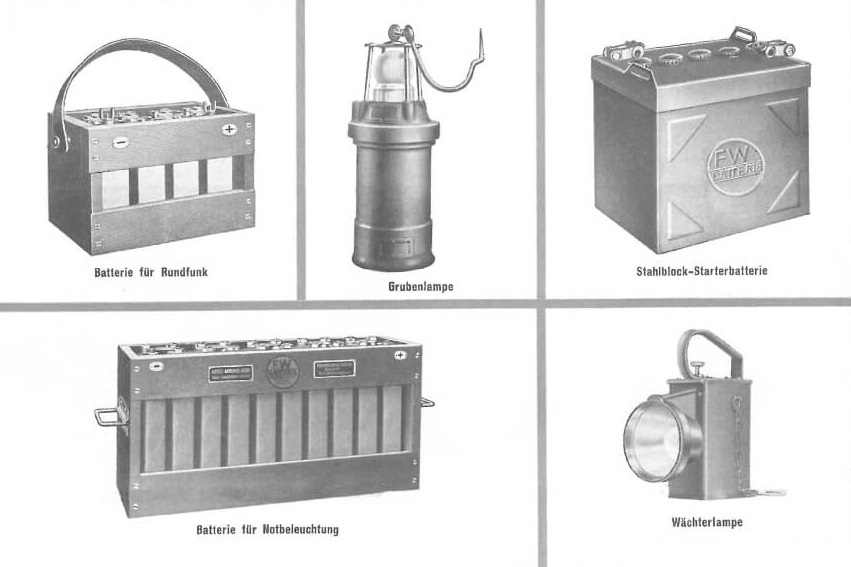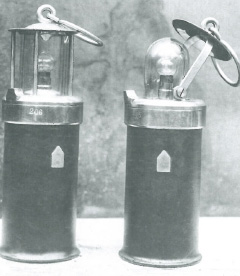From Now on Electric. The History of GAZ part II
History
March 29. 2024
2 min.
For two decades or so, batteries were manufactured in Zwickau only on the side, as parts needed for the company's main produce. This changed after WWI when rechargeable batteries became a hot commodity.

In an earlier article, we established that GAZ, or Friemann & Wolf, as the company was known for the first decades of its existence, used to be a major innovator and supplier of safety miner's lamps. FriWo was founded in 1884, focusing on manufacturing Carl Wolf's own invention, the gasoline safety lamp, but soon incorporated other designs into their product range as well. And not just flame lamps, but since 1899 or 1900 electric miner's lamps as well. Which, of course, needed batteries.
A century ago, Ni-Cd cells not only had a significantly longer lifetime, but also a much higher capacity than lead-acid batteries. One might say that Ni-Cd were the Li-ion batteries of the time, being the most favored, or rather only option for portable devices. Which led to the development of the world's first headlamp equipped by a Ni-Cd battery, patented by FriWo in 1923. With the battery being carried on the user's belt, it looked like straight out of a steampunk comic, but it was quite an improvement compared to FriWo's acclaimed Alkali-lamp Nr. 950, a widely used handheld miner's lamp as well equipped with a Ni-Cd battery.
The future is battery-powered
Meanwhile, electricity began to power all sorts of machinery and devices. In the years following WWI, miner's lamps including those lit by gasoline and carbide remained the mainstay of FriWo's producing assortment. But the variety of electric lighting appliances offered by the company steadily grew to encompass locomotive lamps, signaling lamps and similar equipment, all portable and requiring a battery. FriWo even offered a unique hybrid device, a pneumatic lamp with a backup Ni-Cd battery in case the flow of compressed air was interrupted.
So, once you acquired more than twenty years of experience in building batteries for appliances of your own manufacture, why not supply others as well. While the first car equipped with an electric starter motor appeared as soon as 1911, it was in the first half of the 1920s when this innovation became commonplace. And it was in Zwickau, where the Horch automobile plant was founded in 1904, followed by its offshoot, the Audi factory in 1909. Given the short delivery distance, it was obvious for both manufacturers to source car batteries from FriWo.
Although it is not quite certain, apparently the Horch 10/50 PS and Audi 8/28 PS models produced from 1925 onwards were equipped with FriWo lead-acid batteries. Be it as it may, in 1938, the company manufactured five types of car batteries for 2 V, 6 V and 12 V electrical systems, and two batteries for motorcycles. The demand rose sharply, so that in course of the 1930s, FriWo had to set up three new production lines for lead-acid batteries.
The rise before the fall
Meanwhile, nickel-cadmium batteries established themselves in their own set of applications which included, and still include, railways. In the mid-1930s, the Deutsche Reichsbahn railway operator became a major purchaser of FriWo batteries, using them as power sources for various lighting installations. But FriWo was soon to acquire an even larger customer which sped up the company's gradual shift from mining equipment towards lighting and battery technology.
While FriWo celebrated the manufacture of the 2 millionth Wolf gasoline lamp in 1937, the Nazi regime has already set course for a war of conquest, ramping up the production of all kinds of military gear. FriWo supplied batteries for trucks, panzers and other vehicles, batteries for portable radio units, hand lamps, or battery-powered lighting for air-raid shelters. As of late 1942, a quarter of FriWo's production went to the army, 7 percent to the Luftwaffe and 5 percent to the Kriegsmarine. Roughly a third still was mining equipment, and over a fifth of the produce was supplied to the Reichsbahn, Reichspost and other public services.
FriWo thus fell into the category of Rüstungsbetrieb, or armament factory, being rated as essential for the war effort. FriWo needed to grow in production capacity, but the expansion of the facility was delayed for two years or so due to bureaucracy. And by mid-1944, building materials were so scarce in the Reich that a larger extension of the Zwickau factory wasn't feasible anymore. In the aftermath of the war, FriWo would be divided with the Zwickau site almost ceasing to exist. But more on that in the next volume of our series on GAZ history.
Related articles
Coming Back Stronger. The History of GAZ part IV
November 21. 2024
2 min.
MorePowering the Workers' Paradise. History of GAZ part III
July 11. 2024
2 min.
MoreBringing Light into Darkness. The History of GAZ part I
January 3. 2024
2 min.
MoreOver a Century Old, But Still Modern
December 23. 2022
4 min.
More



